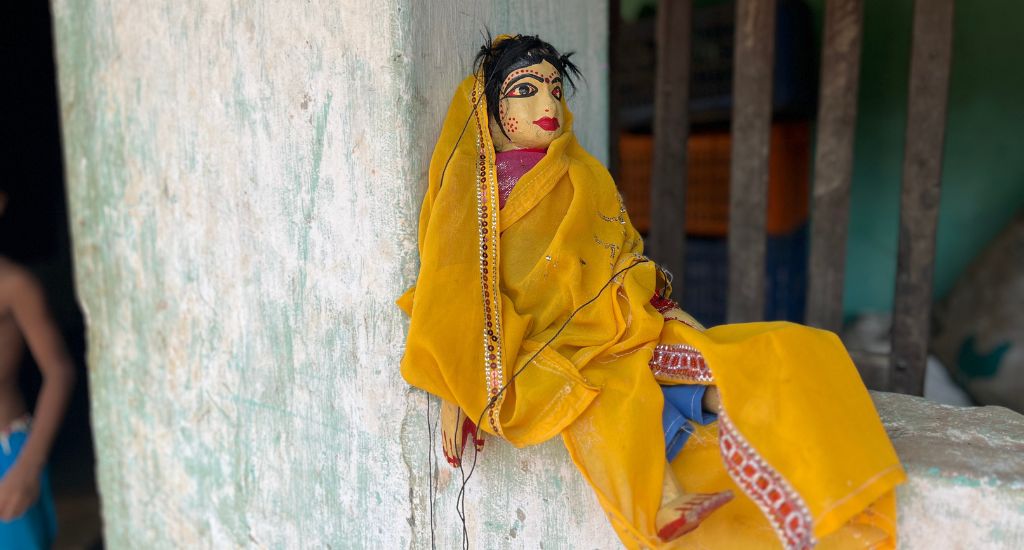
Elderly puppeteers of Odisha keep kandhei nacha alive
Rabi Narayan Jena, Dukhabandhu Jena and Umakanta Jena are fighting to revive the ancient art of kandhei nacha (rod puppetry), despite modern entertainment threatening its existence in Odisha.

Rabi Narayan Jena, Dukhabandhu Jena and Umakanta Jena are fighting to revive the ancient art of kandhei nacha (rod puppetry), despite modern entertainment threatening its existence in Odisha.
On a vibrant stage adorned with colourful backdrops, three elderly puppeteers of Odisha bring to life the enchanting art of kandhei nacha, which literally translates to “dancing dolls attached to rods”. As their puppets dance and sway, the intricate craftsmanship and skilful manipulation captivate the audience.
Children, their faces alight with wonder and excitement, sit wide-eyed, while their parents, equally enthralled, share the joy and nostalgia of the performance. The rhythmic movements of the puppets, combined with traditional music and storytelling, create a magical atmosphere, leaving everyone with memories to cherish.

The small village of Raidihi in Dhenkanal district of Odisha has long been famous for its kandhei nacha, a form of rod puppetry. However, this art form has been teetering on the brink of extinction, threatened by the rise of modern entertainment. It would have vanished but for the dedicated efforts of puppeteers Rabi Narayan Jena, Dukhabandhu Jena, and Umakanta Jena — aged 70, 73 and 60, respectively.
These men consider themselves blessed with the art of rod puppetry since childhood. They grew up idolising their parents and guardians, who dedicated their lives to this craft.
“Today, people go through a lot of stress and with this fast-forward culture of cities, you generally don’t see people happy or smiling anymore. But for the past 40 years of my life, I’ve made every face smile with my performances,” Umakanta said.
In the past, Raidihi hosted special performances every weekend, featuring scenes from the epics Mahabharata and Ramayana, and Kalidas’s play Shakuntala. These shows were part of an effort to impart the values of these mythologies to the people, especially children. The district administration frequently invited these artistes to perform on major occasions, including Laxmi Puja, which is celebrated across Dhenkanal district with much fanfare and devotion. These performances earned them recognition and a modest income.
Also Read: Puppets in Jaisalmer museum preserve old tradition
Over the years, many senior artistes passed away, leaving the village struggling to preserve its puppetry heritage. This was when Rabi, Dukhabandhu and Umakanta decided to shoulder the responsibility of keeping the tradition alive.

They began teaching the village children, dedicating an hour every day to instil in them the intricacies of kandhei nacha. They made their own puppets, depicting boys, girls and animals like elephants, tigers and birds, to tell stories from the Panchatantra for upcoming fairs and jatra theatre.
The wooden puppets used in this form of puppetry range from 12 to 18 inches in height. Each puppet has joints at the neck and shoulders, allowing the upper body to be moved with a rod, while strings hidden in the torso manipulate the arms. The costumes and jewellery of the puppets are inspired by jatra.
Unlike string puppets, kandhei nacha puppets are operated from below, with the puppeteer crouching behind a curtain. The performances typically feature episodes from epics and religious texts. They begin with a musical invocation called stuti, and the dialogues are sung, with the music drawing heavily from both folk and classical tunes.
It didn’t take long for the three men to realise that the children were not enthusiastic about learning the craft. Those who showed interest were unwilling to pursue kandhei nacha as a full-time profession.
“Today, with the kind of modern avenues and opportunities opening for bright minds across the country, children aren’t showing eagerness to take our ancestral craft as a profession as they believe that they’ll have to sleep without money sometimes like the way I’ve been doing,” Dukhabandhu said.
Also Read: Using puppet power to spread messages

Despite these challenges, the trio continues to perform whenever they get the chance, earning numerous awards and recognition from the Odisha government, district administration and local organisers. They receive a regular pension of Rs 6,000 a month from the government, which motivates them to keep practising their art.
However, the Covid-19 pandemic has drastically reduced the demand for kandhei nacha, leaving the village’s once-bustling cultural scene dull and lifeless.
“There was a time when people used to wait dearly for our performances for hours, but now the scenario has just reversed as we wait for people to come and ask us to perform a play for them,” said Rabi.
Raidihi resident Sanjay Pradhan, whose father was an award-winning puppeteer, said: “We seriously need the government’s support. Even if these three mausa (uncles) continue to motivate people across villages, we still need the infrastructure and training to preserve our kandhei tradition.”

In an age where people often abandon their passions, the three last-generation artistes remain dedicated to their craft, having devoted 35-40 years of their lives to mastering it. They hope that their persistence will eventually pay off, inspiring the youth of Raidihi and beyond to revive kandhei nacha.
Also Read: Will Dhinkia lose its betel vines to steel plants?
The lead image on top shows a puppet doll used in kandhei nacha. (Photo by Devashish Biswal)
Devashish Biswal is a graduate of English journalism at the Indian Institute of Mass Communication, Dhenkanal. He has an eye for stories with the potential to grab people’s attention.